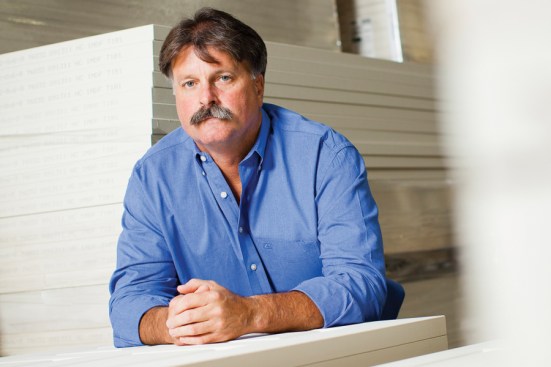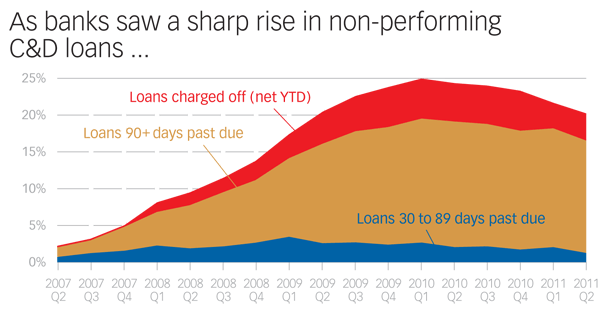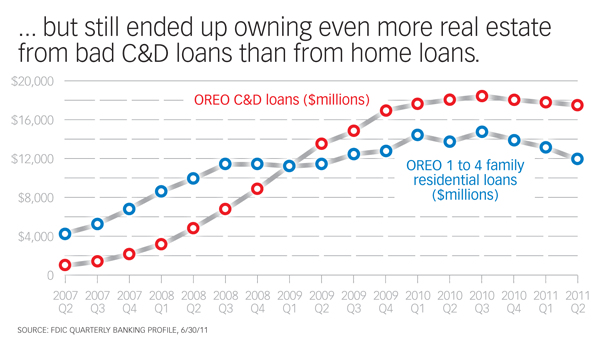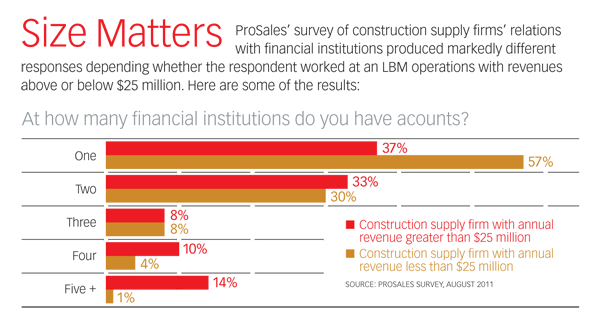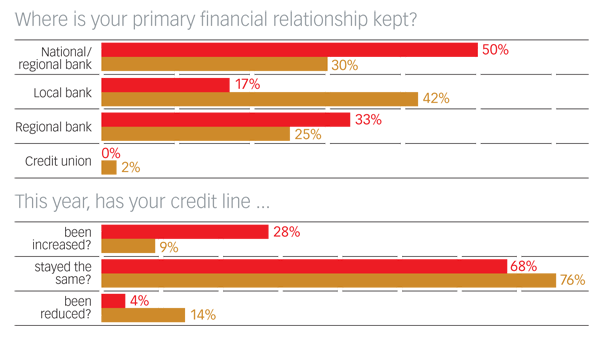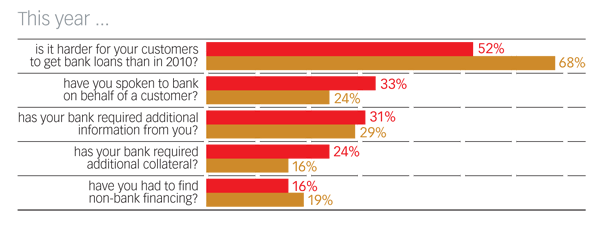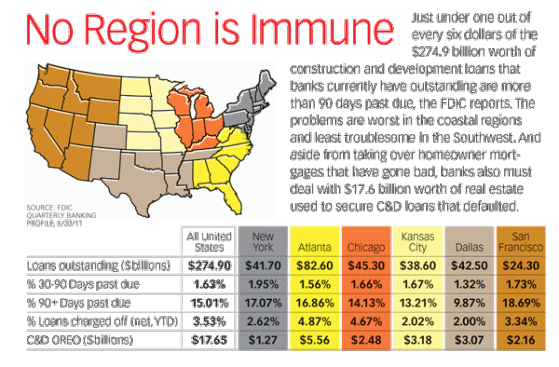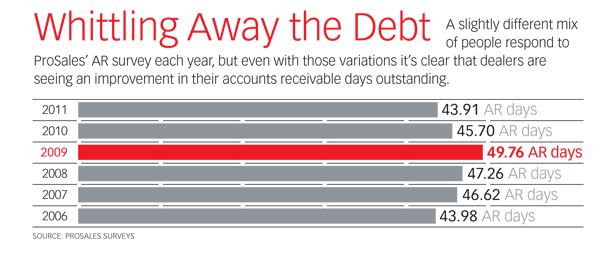Tougher Standards
“We are tighter on credit risk than ever in our history,” another notes. One dealer reports converting some large past-due accounts to five-year notes on receivables with a balloon payment due at the end–and a signed statement of confession attached to the note that defaults to a judgment if the customer can’t pay. Another dealer indicated that he improved things by refusing to intervene when his accounts payable department was on the job.
Dan Chung / www.danchungphoto.com / www.auroraselect.com
Door Knockers: Bankers are imposing ever-tougher terms on LBM co…
“The good old days are a thing of the past,” an Arizona dealer says. “If we can’t get the I’s dotted and the T’s crossed, we make them pay cash.”
While dealers keep a close eye on their credit counts, they also are backing up good customers who are seeking C&D money. Just over 30% of the dealers responding to ProSales’ latest survey said they had spoken this year to a bank on behalf of a builder or remodeler customer who was seeking a loan. Three-fifths of the dealers surveyed said they believe it’s harder for their customers to get bank loans this year than last.
That relative improvement has heartened some, but not all banks, survey respondents suggest. While many dealers reported good relations with their lenders, others sounded more like Rollins at Colonial Sash & Door.
“Banks don’t want to be in our business,” a Virginia dealer believes. “They are there because of long-term relationships or due to the fee income generated by managing the wealth of the business owners, which is held personally, outside of business.”
Get used to it, Matt Ogden says. Ogden is managing principal of Building Industry Partners, a private equity firm that among other things helped create US LBM, and he has worked in finance his entire career.
“I’m a little bit skeptical of the impact a personal relationship with a bank can have on larger matters, such as putting in place credit lines or term loans or real estate facilities,” Ogden says. “At the end of the day, any bank is going to do its work, do its analysis, and the deal has got to fit within its boxes. … Extending credit is a surprisingly unemotional decision for a bank.”
Playing the Field
The idea of sitting across the table from a numbers-driven, seemingly coldhearted banker clearly upsets some dealers we’ve met over the years. LBM executives often say theirs is a relationship-based business, and they see themselves as helping build communities. So when banks retreat, dealers cry foul.
“Banks are delaying the recovery process,” says Jay Torrisi, CFO of Jackson Lumber in Lawrence, Mass. “They have no sense of urgency to close a loan, whether it is a development loan with a builder or a mortgage with a homeowner. They are too conservative to help get us out of this mess.”
To such views Ogden gives two responses. The first is that dealers should think of banks “far more as a commodity and far less as an ally.”
The second is that not all lenders subscribe to the same formula for deciding creditworthiness.
The key to getting the loan, Ogden argues, is less about schmoozing with the banker you know than it is about finding the lender whose formula likes your company’s numbers.
That could take some work. Ogden says that when it comes time to refinance existing debt or arrange for new credit, a dealer should reach out to 20 to 30 lenders. In contrast, the ProSales survey found 46% of dealers have accounts with just one bank, while 31.5% work with two banks, 8.9% with three, and the other 13.8% with four or more banks. In many cases, those additional banks were used merely as places to deposit the day’s cash or save money at a good rate.
There also is no agreement among dealers as to whether it’s good policy to do significant amounts of business with more than one financial source.
“It’s definitely in the dealer’s best interest to have at least two relationships,” argues Ruth Kellick-Grubbs, an LBM consultant. “I like for one to be a strong local bank. I’ve seen many dealers struggle with bank consolidation. They lose their contact, have a new account rep that doesn’t know them or their business and isn’t really interested.”
“Multiple relationships actually don’t help at all,” contends Johan van Tilburg, president and CEO of Tindell’s, the Knoxville, Tenn.-based dealer. “You have to disclose what you are doing with other banks and what balances/payments you have with them. Since you have already committed some collateral, inventory AR or both, there is not much the second/third bank wants, so they are going to have to overcharge you to protect against exposure.”
Besides, van Tilburg adds, “If you had more and one wanted to play ball but the other pulled the rug out from under you, could you now get the first one to take the second’s position? Probably not.”
Richard Heath, a Surfside Beach, S.C.-based accountant who leads LBM roundtables and consults with numerous dealers, notes that some dealers are required by the bank that’s lending them money to do all their banking business with that institution. But when possible, he says he always advises his clients to try to use two different banks. For instance, they can keep the payroll account at a separate company from where they deposit customers’ payments. “If a bank gets nervous about loan or credit line repayment, they have the right in some loan agreements to take money from whatever account you have at the bank for repayment,” he notes. “So having cash in a CD at a bank from which they have not received a loan makes good sense.”
Regardless of where you get the deal, Ogden cautions dealers to remember that the financial commitment doesn’t always remain with the person who shakes your hand. As a result, for whatever papers you’re asked to sign, “you’ve got to treat those documents as seriously as a heart attack,” he says. “Read the fine print. Understand those terms. Maximize your flexibility under those terms. And you need to have a savvy attorney review those documents. It’s not a job for a family lawyer, but rather for a transactions attorney.
“With banks kicking existing customers to the curb or threatening punitive action,” Ogden concludes, “due care needs to be taken when negotiating the details.”
A Source of Extra Credit?
Nearly one in five of the dealer respondents to ProSales’ August survey reported they have had to find a means of financing aside from a bank credit line. At the same time, close to 5% of all dealer respondents said their funding sources included what might be the next great place where construction supply companies will do banking: at their local credit union.
Credit unions are not-for-profit financial institutions owned by their members. The idea for them came to America about 100 years ago when many people couldn’t get served at the local bank. The original chartering rules required that all members must have a common bond; typically, it was where members worked. But in recent decades those rules have been loosened to permit geographic common bonds. Thus, an institution like the USC Credit Union might have been created to serve employees, faculty, students, staff, and alumni of the University of Southern California, but it also can do business with anybody who lives, works, attends school, or even worships inside the city of Los Angeles.
As a result, the roughly 7,500 credit unions in America today now serve roughly 92 million people. For the most part they’re still small; over 80% have less than $100 million in assets. But while personal checking and savings accounts remain their bread-and-butter occupation, they increasingly are making loans to small businesses.
As of March 31, credit unions had on their books nearly 170,000 business loans worth $37.35 billion, according to federal and private statistics that track credit unions. The vast majority of those business loans–nearly 103,000 loans worth $31.35 billion–were secured by real estate, but there also were 12,203 unsecured revolving lines of credit worth $203.2 million. All told, credit unions’ volume of business lending jumped by 41% between January 2008 and March 2011.
These loans aren’t big; they average just $220,000. That’s in part because federal law bars credit unions from having business loans represent more than 12.5% of their assets or 1.75 times the institution’s net worth. Rep. Ed Royce, R-Calif., and Sen. Mark Udall, D-Colo., have introduced legislation to raise that cap to 27.5% of assets. Royce’s bill has 63 co-sponsors, while Udall’s has 20. Both enjoy bipartisan support, and given the drive this fall in Washington for initiatives that boost the economy, the idea is likely to get a close look by Congress, despite banks’ objections.
Maury Beck would welcome such a move. Beck is chief financial officer of N.B. Goodwyn & Sons as well as a member of the board of Argent Credit Union, an institution originally set up for DuPont Fibers workers but which now serves the Richmond, Va., metro area. Beck keeps certificates of deposit at the $188 million institution. Given his company’s annual revenues of $11 million, he says Argent is too small to serve his needs–at least until it expands.
“I’m surprised that other dealers don’t do business with credit unions,” he says.
— Craig Webb
